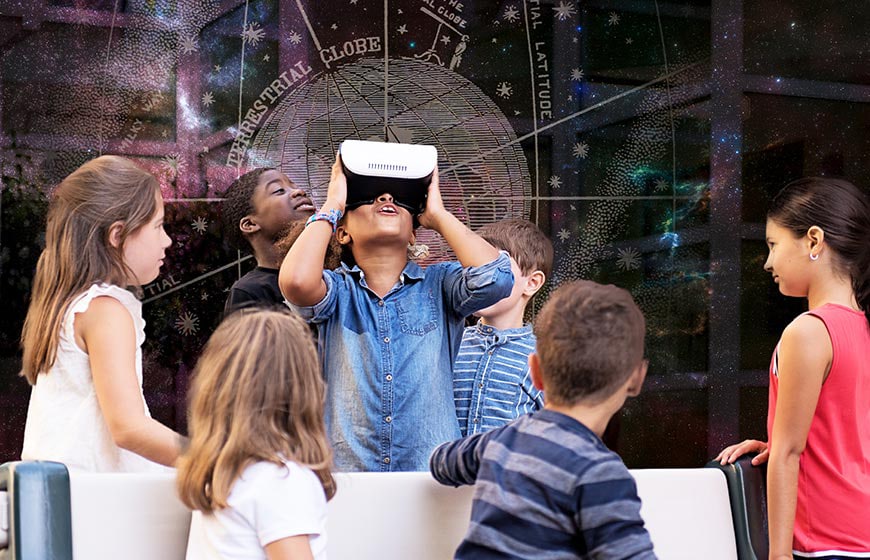November 18, 2024
Discover the Future of Learning With Extended Reality
Uncover the world of extended reality (XR) and how it's revolutionizing the way students interact with digital environments.

With an increased focus on student engagement, extended reality XR technology is becoming a new essential. Schools often find it challenging to innovate and provide engaging learning experiences for diverse needs, especially with limited resources. By integrating XR technology, IT leaders can enhance student engagement through immersive learning experiences that cater to many learning styles, eliminating barriers and empowering IT leaders to create inclusive educational environments.
Furthermore, implementing XR technology doesn’t have to break the bank. Cost-effective options are available for schools on a tight budget. With its ability to create immersive and interactive learning experiences, XR technology offers the potential to redefine how educators and students engage with content. Discover the key benefits of XR technology and the practical insights you need to begin your XR journey.
What Is XR Technology?
XR is an umbrella term that encompasses virtual reality (VR), augmented reality (AR) and mixed reality (MR). These technologies blend the digital and physical worlds, creating environments where users can interact with data in new and exciting ways. VR offers a fully immersive experience of interaction with virtual objects. AR overlays digital information onto the real world. And MR allows for interaction between real and virtual objects. Together, these technologies provide educators with powerful tools to enhance learning.
How XR Technology Transforms K-12 Education
In K-12 education, XR technology is revolutionizing classrooms by making learning more dynamic and engaging. With VR headsets, students can explore ancient civilizations during history lessons in the virtual world or conduct virtual science experiments.
AR applications can bring textbooks to life, allowing students to visualize complex concepts like molecular structures and anatomy in 3D. These technologies foster creativity and critical thinking, encouraging students to become active participants in their education.
Benefits of XR Technology
The benefits of incorporating XR technology into educational settings are vast:
- It enhances retention by offering hands-on learning experiences that are more memorable than passive instruction. Students are more likely to retain information when they learn by doing. Research from ACADEMIA suggests that active learning can improve long-term knowledge retention.
- It caters to various learning styles, providing visual, auditory and kinesthetic experiences.
- It can help develop essential skills, such as problem-solving, collaboration and digital literacy, preparing students for future careers. Industries such as healthcare, manufacturing, construction and engineering are using some form of extended reality for real-time simulations, collaboration and training.
How XR Technology Creates Access and Opportunity
XR technology has the power to provide access to high-quality resources regardless of geographical or economic constraints. Remote and underfunded schools can use VR and AR to offer experiences previously unavailable to their students. For instance, virtual field trips can replace costly physical excursions, ensuring all students have equal opportunities to explore the world beyond their classrooms. XR is opening up possibilities for students with autism to help them develop social skills and career and technology education.
How to Include XR Into Curricula
XR technology can be integrated into various educational settings to enhance learning, but it depends on your educators’ goals and what they’re trying to instruct. VR can help students remember lessons more effectively, while AR may be useful for enhancing specific aspects of a lesson with virtual details.
Cost-effective Options for Implementing XR Technology
Implementing XR technology doesn’t need to break the bank. There are ways to include this immersive technology at a relatively low cost. Many schools already have devices like tablets and smartphones that can run AR applications. VR headsets have become more affordable, and scalable options are available, such as sharing devices among students. Additionally, many software solutions offer subscription models, allowing schools to pay for what they need without significant upfront costs.
Some smaller schools with tight budgets can still benefit from XR technology by utilizing augmented reality. For instance, in an anatomy class where students use Chromebooks, AR can improve the learning experience by enabling teachers to emphasize particular details of the lesson, like the dissection of a frog. This adds an extra layer of immersion for students through their devices. Additionally, IT managers can provide teachers with software tools like Utopia, a virtualized desktop that grants students access to programs such as AutoCAD. This enables them to create virtual reality applications that they can use on their Chromebooks.
Future Trends in XR Technology
The future of XR technology in education looks promising. Virtual reality may become more niche, while augmented reality is likely to dominate due to its lower cost of adoption. If you have a cell phone or tablet, access to AR becomes as simple as using an app. Additionally, as XR technology becomes more mainstream, there will be increased emphasis on developing standards and best practices for implementation.
How CDW Can Help
For IT leaders and instructional technologists seeking to implement XR technology in their schools, CDW offers a range of solutions and expertise. From providing the latest XR hardware to offering expert consultation and support, CDW helps schools and institutions seamlessly integrate XR technology into their curricula, ensuring educators and students can harness its full potential to create enriching educational experiences.
XR technology represents a significant opportunity for educators to enhance teaching and learning. By understanding its benefits and applications, schools can unlock new possibilities for their students.

